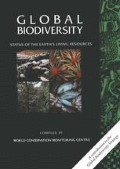Abstract
The objective of this section is to explore how far global biodiversity may have been accounted for by taxonomic description, emphasising diversity at the species level. This is done with reference to the total number of species currently recognised (itself very imprecisely known) and the degree to which we can estimate the completeness of taxonomic knowledge.
Access this chapter
Tax calculation will be finalised at checkout
Purchases are for personal use only
Preview
Unable to display preview. Download preview PDF.
References
Ackery and Vane-Wright. 1984. Milkweed Butterflies. BM(NH), London.
Adis, J., Lubin, Y.D. and Montgomery, G.G. 1984. Arthropods from the canopy of inundated and terra firma forests near Manaus, Brazil, with critical considerations of the Pyrethrum-fogging technique. Studies on Neotropical Fauna and the Environment 19:223–236.
Adis, J. and Schubart, H.O.R. 1985. Ecological research on arthropods in central Amazonian forest ecosystems with recommendations for study procedures. In: Cooley, J.H. and Golley, F.B. (Eds), Trends in Ecological Research for the 1980s. NATO Conference Series, Series 1: Ecology. Plenum Press, London. Pp. 111–144.
Arnett, R.H. 1967. Present and future systematica of the Coleoptera in North America. Annals of the Entomological Society of America 60:162–170.
Arnett, R.H. 1985. American insects: handbook of the insects of America north of Mexico. Van Nostrand Reinhold, New York.
Barnes, R.D. 1989. Diversity of organisms: how much do we know? American Zoologist 29:1075–1084.
Brusca, R.C. and Brusca, G.J. 1990. Invertebrates. Sinauer, Sunderland, Massachusetts.
Casson, D. 1988. Studies on the Hemiptera communities of Dumoga-Bone National Park, Sulawesi. M.Phil. Thesis. Liverpool Polytechnic,.
di Castri, F., Vernhes, J.R. and Younes, T. (in press). A proposal for an international network on inventorying and monitoring of biodiversity. Biology International, Special Issue 27.
Colinvaux, P. 1980. Why Big Fierce Animals Are Rare. Pelican Books, London.
Eliot, J.N. and Kawazoé, A. 1983. Blue Butterflies of the Lycaenopsis Group. BM(NH) London.
Erwin, T.L. 1982. Tropical forests: their richness in Coleoptera and other arthropod species. Coleopterists’ Bulletin 36:74–75.
Erwin, T.L. 1990. Canopy arthropod biodiversity: a chronology of sampling techniques and results. Revista Peruana de Entomologia 32:71–77.
Erwin, T.L. 1991. How many species are there? Revisited. Conservation Biology 5:1–4.
Erwin, T.L. and Scott, J.C. 1980. Seasonal and size patterns, trophic structure and richness of Coleoptera in the tropical arboreal ecosystem: the fauna of the tree Luehea seemannii Triana and Planch in the Canal Zone in Panama. Coleopterists’ Bulletin 34:305–322.
Frank, J.H. and Curtis, G.A. 1979. Trend lines and the number of species of Staphylinidae. Coleopterists’ Bulletin 33:133–149.
Gaston, K.J. 1991a. The magnitude of global insect species richness. Conservation Biology 5:283–296.
Gaston, K.J. 1991b. Body size and probability of description; the beetle fauna of Britain. Ecological Entomology 16:505–508.
Gaston, K.J. 1992. Estimates of the near-imponderable: a reply to Erwin. Conservation Biology 5:564–566.
Goodwin. 1986. Crows of the World. BM(NH), London.
Grassle, J.F. 1989. Species diversity in deep-sea communities. TREE 4:12–15.
Grassle, J.F. 1991. Deep-sea benthic biodiversity. Bioscience 41:464–469.
Grassle, J.F., Laserre, P., McIntyre, A.D. and Ray, C.G. 1991. Marine biodiversity and ecosystem function. Biology International, Special Issue 23:i–iv, 1-19. IUBS, Paris.
Hammond, P.M. 1990. Insect abundance and diversity in the Dumoga-Bone National Park, N. Sulawesi, with special reference to the beetle fauna of lowland rain forest in the Toraut region. In: Knight, W.J. and Holloway, J.D. (Eds), Insects and the Rain Forests of South East Asia (Wallacea). Royal Entomological Society, London. Pp. 197–254.
Hawksworth, D.L. 1991. The fungal dimension of biodiversity: magnitude, significance and conservation. Mycological Research 95:641–655.
Hodkinson, I.D. and Casson, D. 1991. A lesser predilection for bugs: Hemiptera (Insecta) diversity in tropical rain forests. Biological Journal of the Unnean Society of London 43:101–109.
Lawrence, J.F. 1982. Coleoptera. In: Parker, S.P. (Ed.), Synopsis and Classification of Living Organisms. McGraw-Hill, New York. Pp. 482–553.
May, R.M. 1988. How many species are there on earth? Science 241:1441–1449.
May, R.M. 1990. How many species? Philosophical Transactions of the Royal Society B330:293–304.
Mayr, E., Linsley, E.G. and Usinger, R.L 1953. Method and principles of systematic zoology. McGraw-Hill, New York.
National Science Board 1989. Loss of Biological Diversity: a global crisis requiring international solutionsLoss of Biological Diversity: a global crisis requiring international solutions. National Science Foundation, Washington, DC.
Noyes, J.S. 1989. The diversity of Hymenoptera in the tropics with special reference to Parasitica in Sulawesi. Ecological Entomology 14:197–207.
Poinar, G.O. 1983. The Natural History of Nematodes. Prentice Hall, Englewood Cliffs, NJ.
Reid, W.V. and Miller, K.R. 1989. Keeping options alive. The scientific basis for conserving biodiversity. World Resources Institute, Washington, DC.
Sibley, C.G. and Monroe, B.L. Jr 1990. Distribution and Taxonomy of Birds of the World. Yale University Press, Yale.
Simon, H.R. 1983. Research and publication trends in systematic zoology. Ph.D. thesis. The City University, London.
Solbrig, O. (Ed.) 1991. From genes to ecosystems: a research agenda for biodiversity. Report of an IUBS-SCOPE-UNESCO workshop, Harvard Forest, Petersham, Ma. USA, June 27-July 1, 1991. IUBS, Cambridge, Mass.
Stork, N.E. 1987. Guild structure of arthropods from Bornean rain forest trees. Ecological Entomology 12:69–80.
Stork, N.E. 1988. Insect diversity: facts, fiction and speculation. Biological Journal of the Unnean Society of London 35:321–337.
Stork, N.E. 1991. The composition of the arthropod fauna of Bornean lowland rain forest trees. Journal of Tropical Ecology 7:161–180.
Southwood, T.R.E. 1978. The components of diversity. In Mound, L.A. and Waloff, N. (Eds), Diversity of Insect Faunas. Symposia of the Royal Entomological Society of London. 9. Blackwell Scientific Publications, Oxford.
Valiela, I. 1984. Marine Ecological Processes. Springer Verlag, New York.
Wolf, E.C. 1987. On the brink of extinction: conserving the diversity of life. [WorldWatch Paper No. 78]. WorldWatch Institute, Washington, DC.
Author information
Authors and Affiliations
Editor information
Rights and permissions
Copyright information
© 1992 Springer Science+Business Media Dordrecht
About this chapter
Cite this chapter
Hammond, P. (1992). Species Inventory. In: Groombridge, B. (eds) Global Biodiversity. Springer, Dordrecht. https://doi.org/10.1007/978-94-011-2282-5_4
Download citation
DOI: https://doi.org/10.1007/978-94-011-2282-5_4
Publisher Name: Springer, Dordrecht
Print ISBN: 978-94-010-5012-8
Online ISBN: 978-94-011-2282-5
eBook Packages: Springer Book Archive

